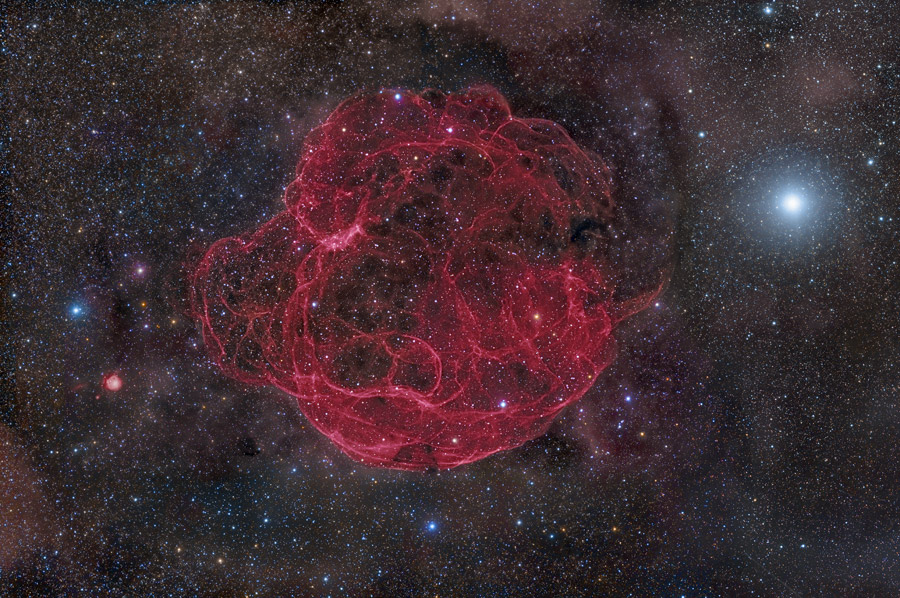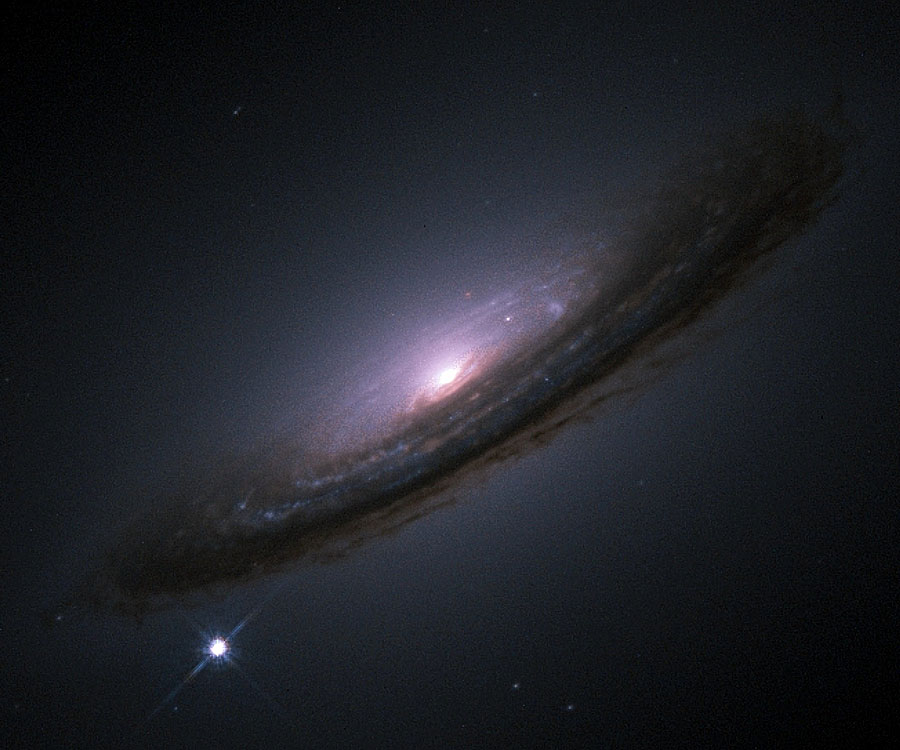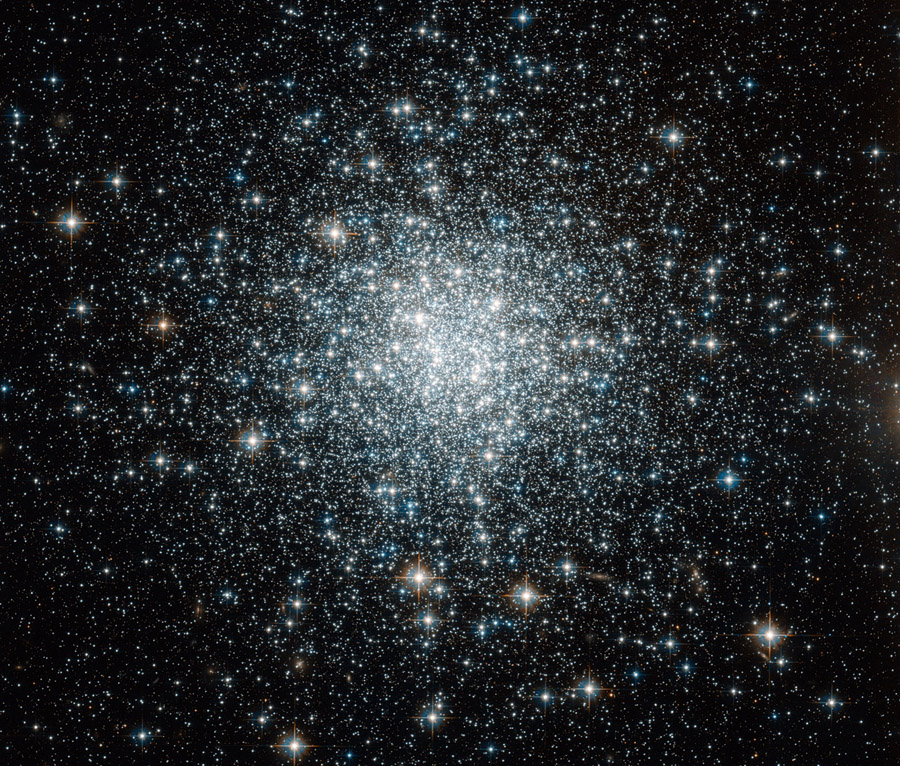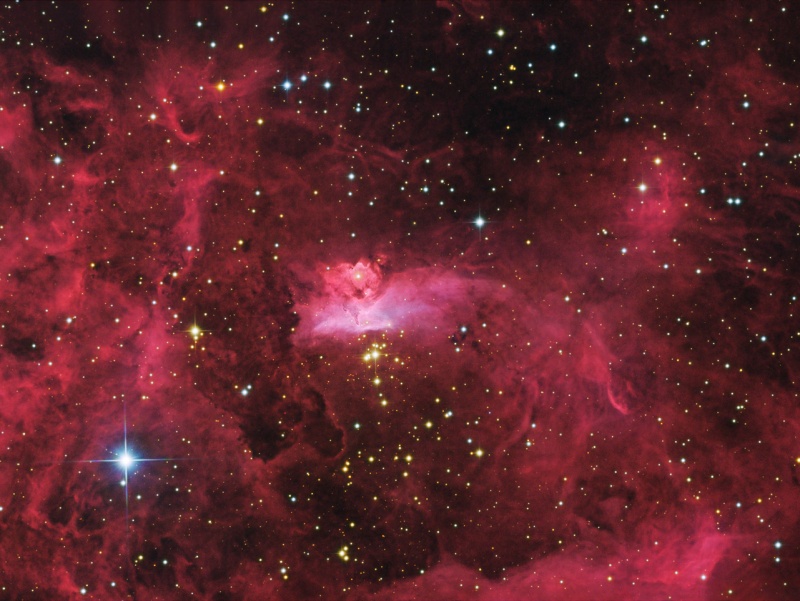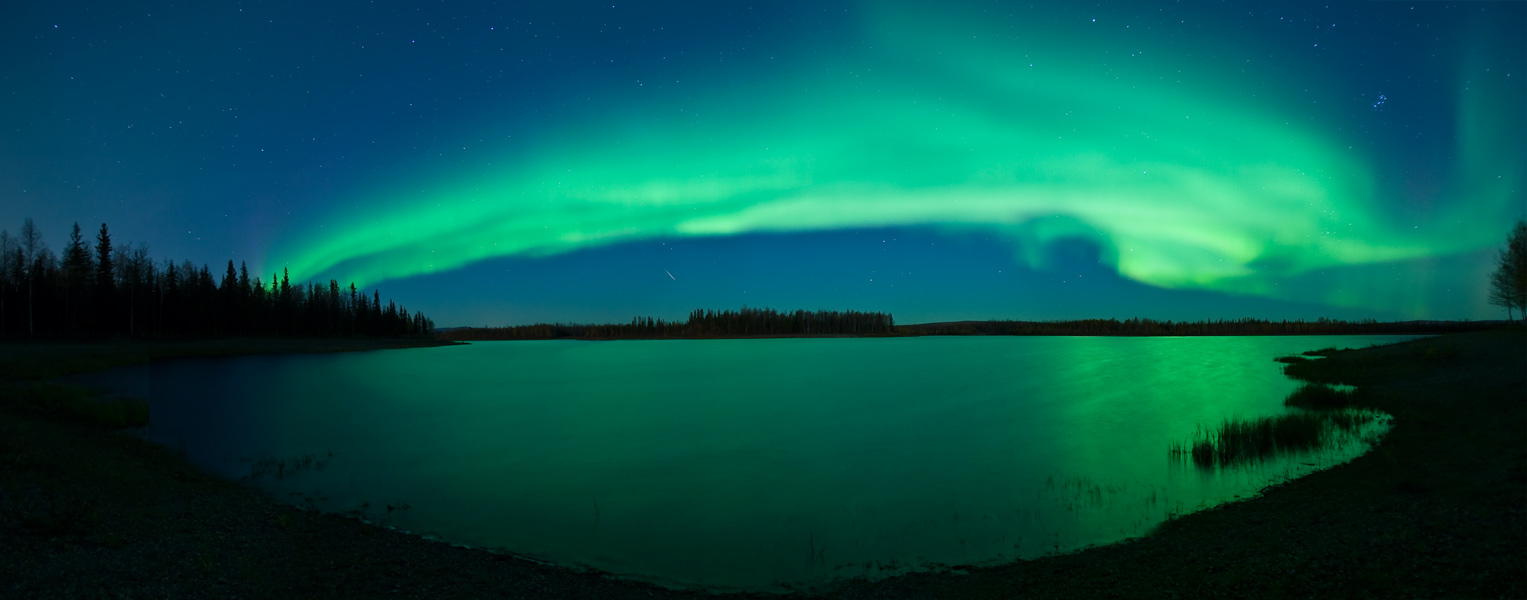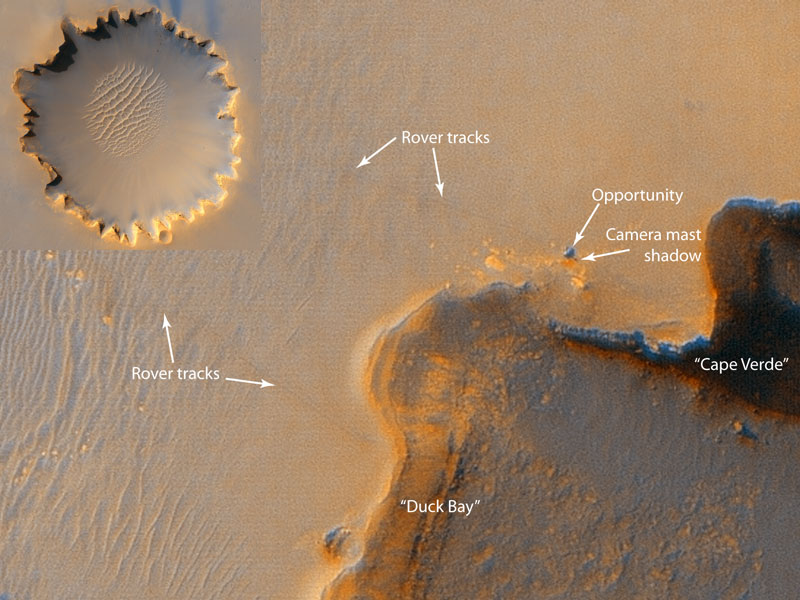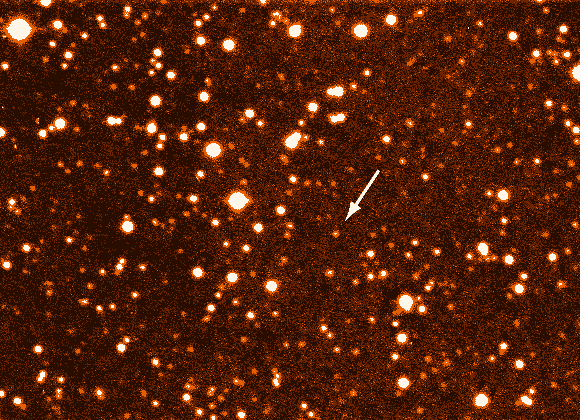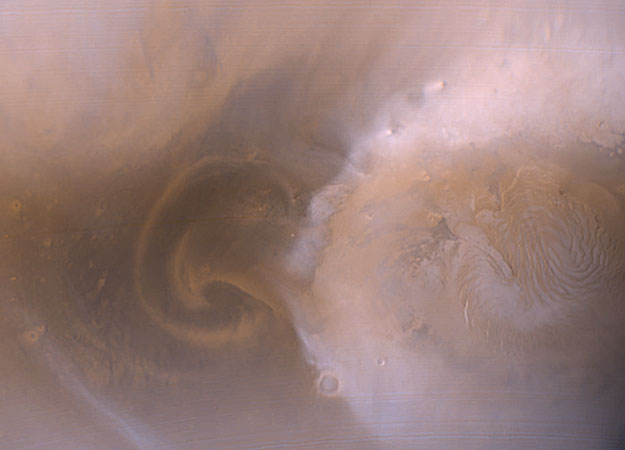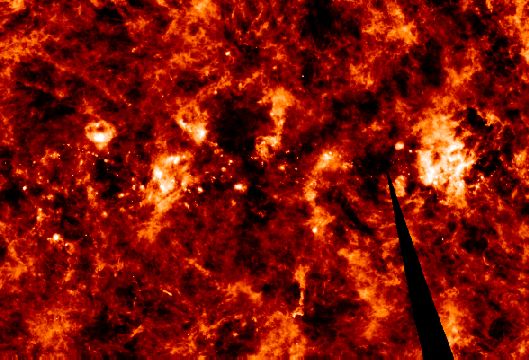| << Previous | Index | Next >> |
2014 The Pacific Ocean and Chilean coast lie below this sea of clouds. Seen through the subtle colors of the predawn sky a lunar eclipse is in progress above, the partially eclipsed Moon growing dark. The curved edge of planet Earth's shadow still cuts across the middle of the lunar disk as the Moon sinks lower toward the western horizon. In fact, from this southern hemisphere location as well as much of eastern North America totality, the Moon completely immersed within Earth's shadow, began near the time of moonset and sunrise on October 8. From farther west the total phase could be followed for almost an hour though, the darker reddened Moon still high in the night sky.
2013
2012 It's easy to get lost following the intricate filaments in this detailed mosaic image of faint supernova remnant Simeis 147 (S147). Also cataloged as Sh2-240, it covers nearly 3 degrees or 6 full moons on the sky. That's about 150 light-years at the stellar debris cloud's estimated distance of 3,000 light-years. Anchoring the frame at the right, bright star Elnath (Beta Tauri) is seen towards the boundary of the constellations Taurus and Auriga, almost exactly opposite the galactic center in planet Earth's sky. This sharp composite includes image data taken through a narrow-band filter to highlight emission from hydrogen atoms tracing the shocked, glowing gas. The supernova remnant has an estimated age of about 40,000 years, meaning light from the massive stellar explosion first reached Earth 40,000 years ago. But the expanding remnant is not the only aftermath. The cosmic catastrophe also left behind a spinning neutron star or pulsar, all that remains of the original star's core.
2011 Thirteen years ago results were first presented indicating that most of the energy in our universe is not in stars or galaxies but is tied to space itself. In the language of cosmologists, a large cosmological constant is directly implied by new distant supernova observations. Suggestions of a cosmological constant (lambda) were not new -- they have existed since the advent of modern relativistic cosmology. Such claims were not usually popular with astronomers, though, because lambda is so unlike known universe components, because lambda's value appeared limited by other observations, and because less-strange cosmologies without lambda had previously done well in explaining the data. What is noteworthy here is the seemingly direct and reliable method of the observations and the good reputations of the scientists conducting the investigations. Over the past thirteen years, independent teams of astronomers have continued to accumulate data that appears to confirm the existence of dark energy and the unsettling result of a presently accelerating universe. This year, the team leaders were awarded the Nobel Prize in Physics for their work. The above picture of a supernova that occurred in 1994 on the outskirts of a spiral galaxy was taken by one of these collaborations.
2010 Globular star clusters roam the halo of our Milky Way Galaxy. Gravitationally bound, these spherical groupings of typically several hundred thousand stars are ancient, older than the stars of the galactic disk. In fact, measurements of globular cluster ages constrain the age of the Universe (it must be older than the stars in it!) and accurate cluster distance determinations provide a rung on the astronomical distance ladder. Globular star cluster NGC 6934 itself lies about 50,000 light-years away in the constellation Delphinus. At that distance, this sharp image from Hubble's Advanced Camera for Surveys spans about 50 light-years. The cluster stars are estimated to be some 10 billion years old.
2009 Lurking behind dust and stars near the plane of our Milky Way Galaxy, IC 10 is a mere 2.3 million light-years distant. Its light dimmed by the intervening dust, the irregular dwarf galaxy still shows off vigorous star-forming regions that shine with a telltale reddish glow in this colorful skyscape. In fact, also a member of the Local Group of galaxies, IC 10 is the closest known starburst galaxy. Compared to other Local Group galaxies, IC 10 has a large population of newly formed stars that are massive and intrinsically very bright, including a luminous X-ray binary star system thought to contain a black hole. Located within the boundaries of the northern constellation Cassiopeia, IC 10 is about 5,000 light-years across.
2008 Massive stars lie within NGC 6357, an expansive emission nebula complex some 8,000 light-years away in the tail of the constellation Scorpius. In fact, positioned just below center in this close-up view of NGC 6357, star cluster Pismis 24 includes some of the most massive stars known in the galaxy, stars with over 100 times the mass of the Sun. The nebula's bright central region also contains dusty pillars of molecular gas, likely hiding massive protostars from the prying eyes of optical instruments. Intricate shapes in the nebula are carved by interstellar winds and energetic radiation from the young and newly forming massive stars. This alluring telescopic view spans just under 50 light-years at the estimated distance of NGC 6357.
2007 Sometimes, after your eyes adapt to the dark, a spectacular sky appears. In this case, a picturesque lake lies in front of you, beautiful green aurora flap high above you, brilliant stars shine far in the distance, and, for a brief moment, a bright meteor streaks by. This digitally fused breathtaking panorama was captured late last month across one of the Chena Lakes in North Pole, Alaska, USA, and includes the Pleiades open cluster of stars on the image right. The shot is unusual not only for the many wonders it has captured simultaneously, but because lakes this far north tend to freeze and become non-reflecting before a sky this dark can be photographed.
2006 An unusual spot has been found on Mars that scientists believe is not natural in origin. The spot appears mobile and is now hypothesized to be a robot created by an intelligent species alien to Mars. In fact, the spot appears to be NASA's robotic Opportunity rover currently rolling across Mars. The ability to see the Martian rover from orbit has recently been demonstrated by the High Resolution Imaging Science Experiment on NASA's Mars Reconnaissance Orbiter (MRO). The new spacecraft achieved orbit around Mars in 2006 March. Last week, MRO imaged the location of Victoria Crater and the rover Opportunity that had just arrived there. In the above image at spectacularly high resolution, objects about one meter in size are resolved, and this includes the rolling rover. Such images may help scientists better determine if any safe path exists for Opportunity to enter large crater. In the inset image on the upper left, the whole of Victoria Crater was also imaged by MRO.
2005 It takes a big rocket to go into space. In 2003 April, this huge Russian rocket was launched toward Earth-orbiting International Space Station (ISS), carrying two astronauts who will make up the new Expedition 7 crew. Seen here during rollout at the Baikonur Cosmodrome, the rocket's white top is actually the Soyuz TMA-2, the most recent version of the longest serving type of human spacecraft. The base is a Russian R7 rocket, originally developed as a prototype Intercontinental Ballistic Missile in 1957. The rocket spans the width of a football field and has a fueled mass of about half a million kilograms. Russian rockets like this remain a primary transportation system to the International Space Station (ISS). Last week, a similar rocket successfully launched a spaceflight participant and two Expedition 12 astronauts to the space station.
2004 This vintage 60-kopek stamp celebrates a dramatic achievement. On the 7th of October, 1959 (7/X/1959), the Soviet interplanetary station which has come to be called "Luna 3" successfully photographed the far side of the moon giving denizens of planet Earth their first ever view of this hidden hemisphere. Lacking the digital image technology familiar now, Luna 3 took the pictures on 35mm film which was automatically developed on board. The pictures were then scanned and the signal transmitted to Earth days later in what was perhaps also the first interplanetary fax. In all, seventeen pictures were received providing enough coverage and resolution to construct a far side map and identify a few major features. Depicted on the stamp are regions dubbed the Sea of Moscow, the Soviet Mountains, the Bay of Astronauts, and the Sea of Dreams.
2003 This view of gas giant Jupiter, made from data recorded at the Very Large Array radio observatory near Socorro, New Mexico, may not look too familiar. In fact, there is no sign of a bright, round planet striped with cloud bands, sporting a Great Red Spot. Instead, the radio waves mapped in this false-color image are produced by energetic electrons trapped within Jupiter's intense magnetic field. The radio emitting region extends far beyond Jupiter's cloud tops, to over twice the visible radius of the planet, and surrounds Jupiter like an oversized version of Earth's Van Allen radiation belt. While it glows strongly at radio wavelengths, Jupiter's radiation belt is invisible in the more familiar optical and infrared views which show the Jovian cloud tops and atmospheric features in reflected sunlight.
2002 Asteroids almost as large as planets are still being discovered in our own Solar System. Recently an asteroid more than half the size of Pluto was found orbiting at a distance only a little further than the Solar System's most distant planet. The large asteroid moves relative to background stars in the discovery images shown above taken by the Oschin Telescope at Palomar, California, USA. Quaoar, the name suggested for the space rock by its discoverers, is one of several large asteroids discovered recently that roam in the distant Kuiper Belt. Quaoar's size was resolved by images from the Hubble Space Telescope. Quaoar is likely a cold world covered in ice from which the Sun appears only as a particularly bright star.
2001 How did large rocks come to be scattered on the surface of asteroid Eros? Eros stands out not only because of its proximity to Earth but also because it was visited recently by NASA's NEAR-Shoemaker spacecraft. After arriving at Eros in 2000 February, the robot probe was maneuvered to a controlled landing earlier this year. Although NEAR-Shoemaker is no longer active, scientists are still poring over the images and data, finding new mysteries, and drawing new hypotheses about the ancient tumbling space mountain. For example, analyzing the locations of rocks has led to the hypothesis that many of them originated in a single large collision that occurred possibly about a billion years ago. Still unknown, however, includes why Eros has unusual ponds of blue dust.
2000 On August 29, a large dust storm was photographed erupting out from the north polar cap of Mars. Such dust storms are not uncommon as summer advances in the north. In the above picture taken by the Mars Global Surveyor spacecraft currently orbiting Mars, the white material is frozen carbon dioxide that covers much of the extreme north. As the north polar cap region begins to thaw, a temperature difference occurs between the cold frost region and recently thawed surface, resulting in swirling winds between the adjacent regions. Visible in the storm is a strong central jet about 900 kilometers long that is creating symmetric swirling vortices. Although winds can reach 100 km/hour, the thin atmosphere of Mars usually makes such storms less destructive than similar storms on Earth.
1999 Astronomers have discovered that looking at dust along the plane of our Milky Way Galaxy is a bit like looking into a frothy glass of beer. The dust between stars in our galaxy appears to be arranged like a foam with bubbles and voids -- churned by shocks and winds generated as stars cycle through their lives. This processed infrared image, based on data from NASA's IRAS satellite, maps the radiation from the edges of galactic dust clouds and reveals the complex distribution. The image covers an area of about 40x60 degrees centered on the galactic plane near the Cygnus region. It shows bright bubble-shaped and arc-like dust clouds around the supernova remnants and starbirth regions embedded in the galactic disk.
1998 While searching the skies above 18th century France for comets, astronomer Charles Messier diligently recorded this object as number 27 on his list of things which are definitely not comets. So what is it? Well, 20th century astronomers would classify it as a Planetary Nebula ... but it's not a planet either, even though it may appear round and planet-like in a small telescope. Messier 27 (M27) is now known to be an excellent example of a gaseous emission nebula created as a sun-like star runs out of nuclear fuel in its core. The nebula forms as the star's outer layers are expelled into space, with a visible glow generated by atoms excited by the dying star's intense but invisible ultraviolet light. Known by the popular name of the "Dumbbell Nebula", the beautifully symmetric interstellar gas cloud is about 1,200 light-years away in the constellation Vulpecula. This gorgeous synthetic color picture of M27 was produced during testing of the European Southern Observatory's new Very Large Telescope.
1997 Comet Hale-Bopp's recent encounter with the inner Solar System allowed many breath-taking pictures. Above, Comet Hale-Bopp was photographed on March 8th in the constellation of Cygnus. Visible on the right in red is the North American Nebula, a bright emission nebula observable from a dark location with binoculars. The North American Nebula is about 1500 light years away, much farther than the comet, which was about 8 light minutes away. Several bright blue stars from the open cluster M39 are visible just above the comet's blue ion tail.
1996 Andromeda is the nearest major galaxy to our own Milky Way Galaxy. Our Galaxy is thought to look much like Andromeda. Together these two galaxies dominate the Local Group of galaxies. The diffuse light from Andromeda is caused by the hundreds of billions of stars that compose it. The several distinct stars that surround Andromeda's image are actually stars in our Galaxy that are well in front of the background object. Andromeda is frequently referred to as M31 since it is the 31st object on Messier's list of diffuse sky objects. M31 is so distant it takes about 2 million years for light to reach us from there. Much about M31 remains unknown, including why the center contains two nuclei.
1995 Dione, one of Saturn's larger moons, is remarkable for its bright surface streaks. These streaks run across some of Dione's many craters, which indicate that the process which created the streaks occurred later than the process which created the craters. Dione is made of mostly water ice but its relatively high density indicates that it contains much rock inside. Dione was discovered by Giovanni Cassini in 1684. NASA's Cassini mission to Saturn is currently scheduled for launch in October 1997. Dione's orbit is remarkable it that it also houses the much smaller moon Helene. This moon, once designated "Dione B", precedes Dione by about 1/6th of an orbit.
| << Previous | Index | Next >> |


